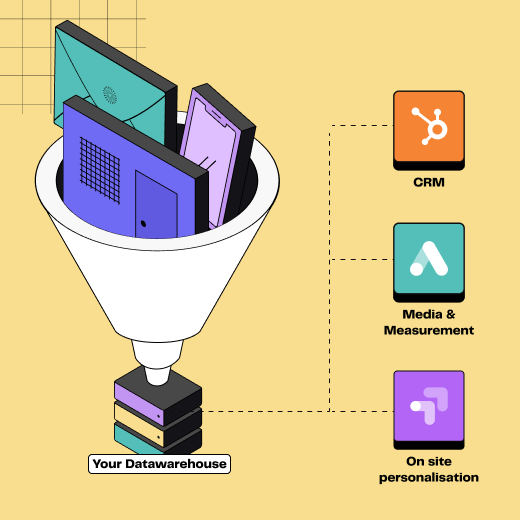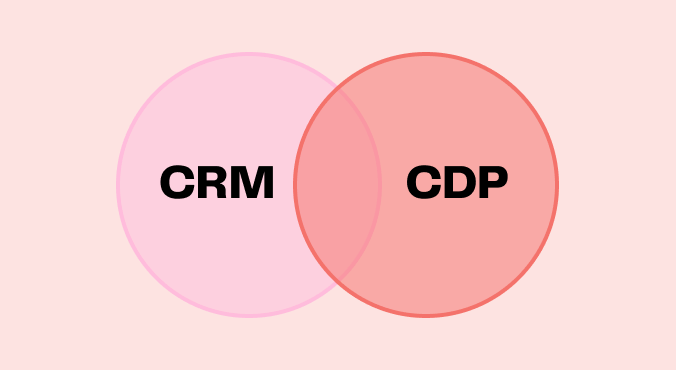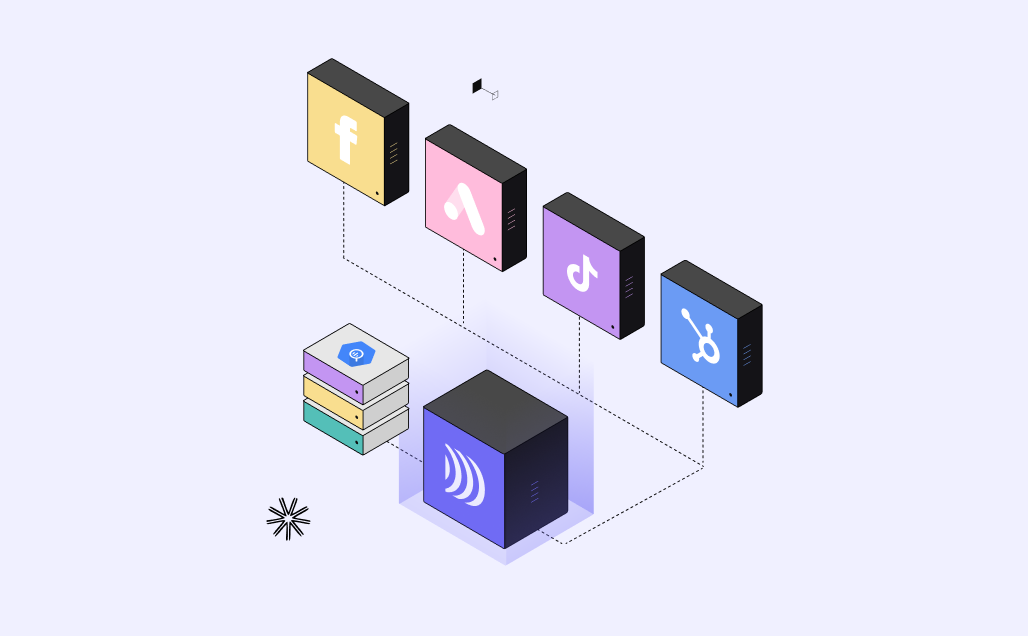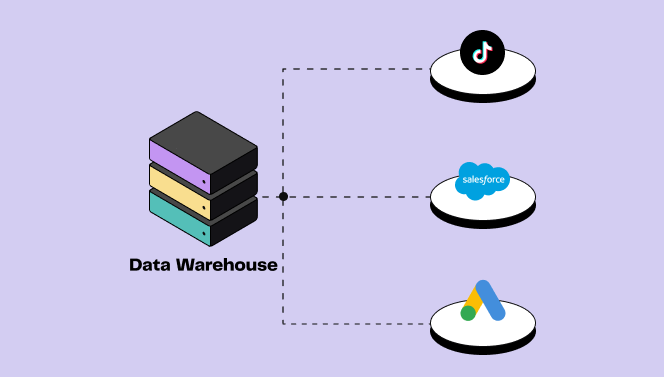
The Rise of Reverse ETL in Modern Data Stack strategies
7min • Dec 1, 2023

Alexandra Augusti
Strategy & Operations Manager
The Rise of Reverse ETL in Modern Data Stack Strategies
Being around since 2018, Reverse ETL is quite a new family of software. Really popular since 2021, it already plays a key role in the modern data stack, reshaping how businesses harness the power of their centralized data for a better data activation.
In this blog post, you'll learn how Reverse ETL can save you time and money by answering these questions:
What is ETL?
What is Reverse ETL?
How Reverse ETL works?
What are the alternative tools to Reverse ETL?
What are the benefits of Reverse ETL?
What is ETL?
To understand what a reverse ETL is, it is essential to grasp the traditional ETL process. ETL stands for Extract, Transform and Load and designates a process that tools of the same name can perform. These tools basically Extract data from the organization’s different data sources, Transform it and finally Load it into a data warehouse.

Illustration of ETL process
💡 ELT also exists. The differences between ELT and ETL processes are more significant than just switching two letters. It determines how, when and where the data transformation is performed.
In the ETL process, raw data is transformed before it's loaded into the data warehouse. In that case, the raw data is not available in the data warehouse. In contrast, the ELT process involves loading raw data into the data warehouse first, and then performing transformations on the stored data.
Since the 2010s, huge investments have been done in the Cloud Data infrastructure. Recent research even forecasts a 22% annual growth rate for cloud data storage.
Several reasons can be can be put forward:
Scalability: Substantial upfront investments in hardware are useless as Cloud Data warehouse allow to handle varying workloads
Cost Efficiency: Pay-as-you-go model reduces upfront expenses
Flexibility and Agility: Cloud Data warehouse offer a quick deployment and an easy integration.
Security: All solutions go with robust measures, encryption, and compliance certifications.
With stricter and stricter regulations on first party data, cloud solutions can be the perfect way to regain control over your it to address customer requirements. Yet, most of this data centralized in data warehouses is underutilized: in 2021, only 9% of companies could optimize dynamic execution across channels throughout the customer journey to achieve operational outcomes (source).
Indeed, once data resides in the warehouse, retrieving and utilizing it in business tools becomes a challenge. This is where Reverse ETL comes into play...
What is Reverse ETL ?
Reverse ETL is the process of syncing data from a data warehouse to the business tools used by the marketing, sales, support and operations teams. This process leverages your existing data stack to allow automated and personalized customer experiences.
Most of the time, when business teams need data in their tools, they have to submit IT tickets and wait a long time to finally have it in their marketing / analytics / operational tools. Reverse ETL bridges the gap between data and business teams. It basically has an inverted function of ETL, allowing to transfer centralized data from the data warehouse to all business / operational applications.
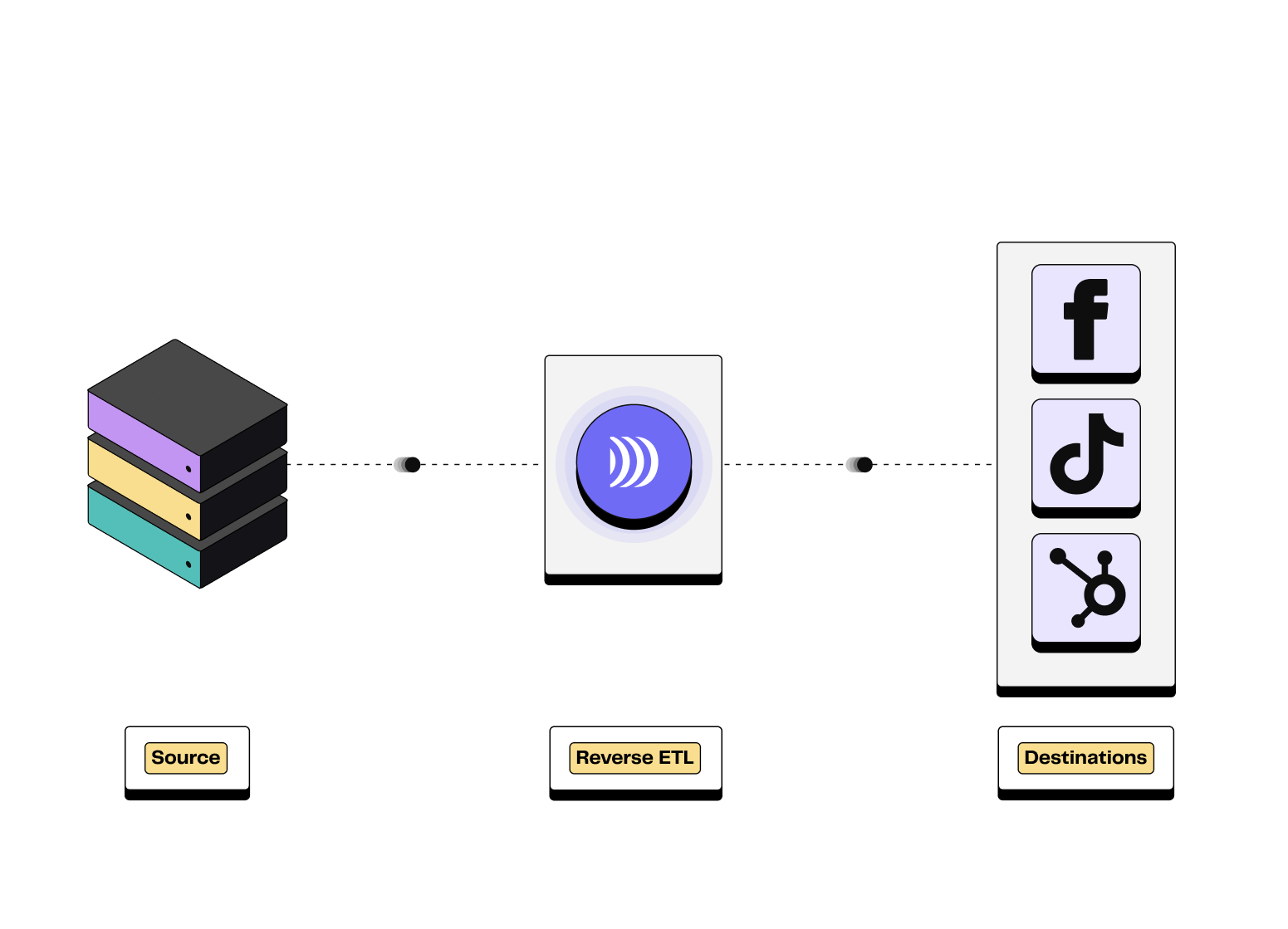
Illustration of Reverse ETL process
Reverse ETL are not only data pipelines. Beyond data transfer, it empowers organizations with data transformation processes before sending it to business applications. Functions like data cleansing, segmentation, and audience creation enhance the usability and relevance of the data across diverse operational systems.
Think of Reverse ETL as a pipeline linking your data warehouse to your entire organization. It helps distribute the detailed customer data from your warehouse to different teams in your business for practical use.
👉🏼 In short, Reverse ETL enables data synchronization across different systems and apps for accuracy and coherence.
Download our complete guide to Reverse ETL!
👇
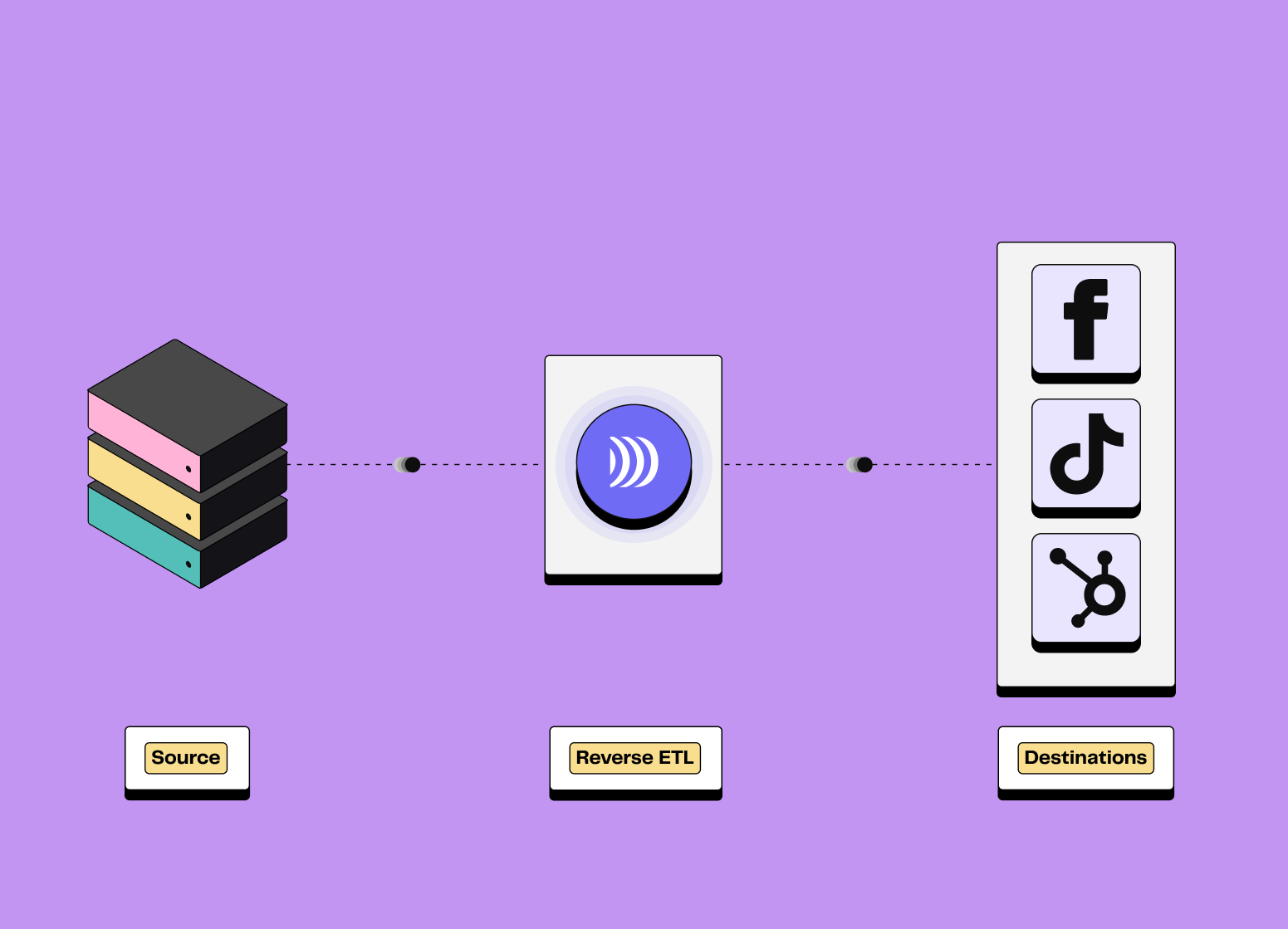
Complete guide to Reverse ETL
All you need to understand about Reverse ETL and know to choose the correct one
How Reverse ETL works?
Reverse ETL operates by executing queries on your data warehouse and transferring the results to your selected downstream tool (whether an advertising destination, a CRM or a marketing automation platform).
There are 5 main components to a reverse ETL:
Source: It refers to the data warehouse (or data lake) where all the data you want to get value from is stored. Snowflake, or Google BigQuery are among the most common data warehouses.
Models: Data model serves as the representation of your business data, defining the data you want your business teams to have access to. It is generally created and maintained by a data expert user familiar with the data warehouse. Once it's set up, everyone can use it easily without having to write any code.
Segments: A segment is a subset of the data model. For instance, it is possible to create a segment of “users living in Europe” or a segment of “users who spent more than 100€”, from the Customers entity (defined in the model).
Syncs: it refers to the process of syncing a segment’s data with a downstream tool on a defined schedule. You can configure multiple syncs from the same data model to different destinations, ensuring all parts of your business are working off the same source of truth.
Destinations: A destination refers to any external tool or service to which you can send source data. This is where the data is usually accessed and utilized by the end users. The most common destinations are ad platforms, CRMs or marketing automation platforms.
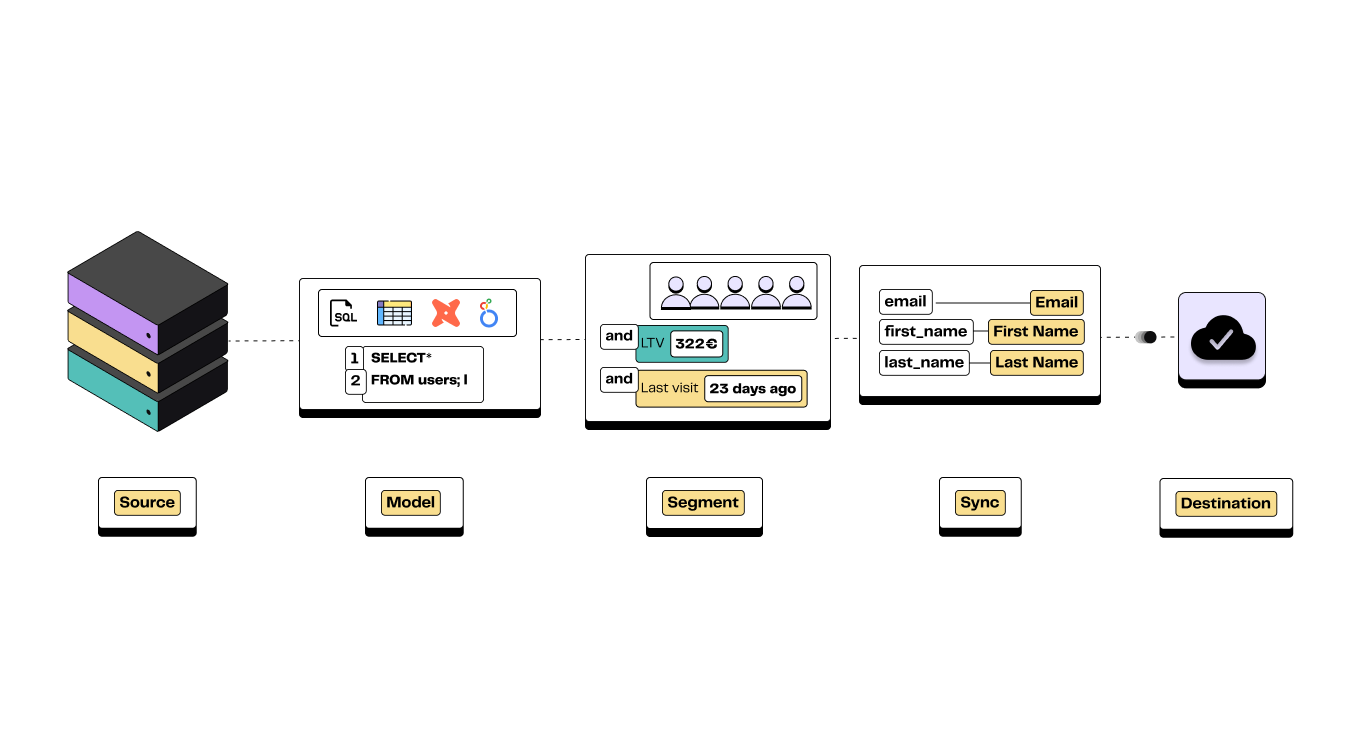
Core components of Reverse ETL
🌟 Several categories of Reverse ETL exist, and several players are positioning themselves on the market. We've written a Reverse ETL benchmark to help you choose the right solution for your business.
What are Reverse ETL alternatives?
Moving data can be done in different ways: manual uploads, with custom pipelines or with other platforms such as iPaaS or CDP.
Reverse ETL vs. iPaaS
Integration Platform as a Service (iPaas) is a platform that connects software applications so that a specific trigger in one tool results in a specific response in the other. For instance, a form submission on Typeform can automatically create a new contact in Hubspot.
iPaaS can connect applications via user-friendly APIs, which is really great if you’re talking about a simple point-to-point integration without dependencies.
An iPaaS simply connects systems in a 1-1 capacity and has several limitations:
It generates a complex network of pipelines and workflows that aren't scalable.
As workflows become complex, users need knowledge of APIs, negating the "no-code" benefit, as business teams will need help from data teams.
It’s not designed for large-volume batch updates (or is extremely costly if you do so)
It’s not based on a Customer 360 and can result in inconsistent customer experiences
It works like a “black box” and raises governance and quality issues
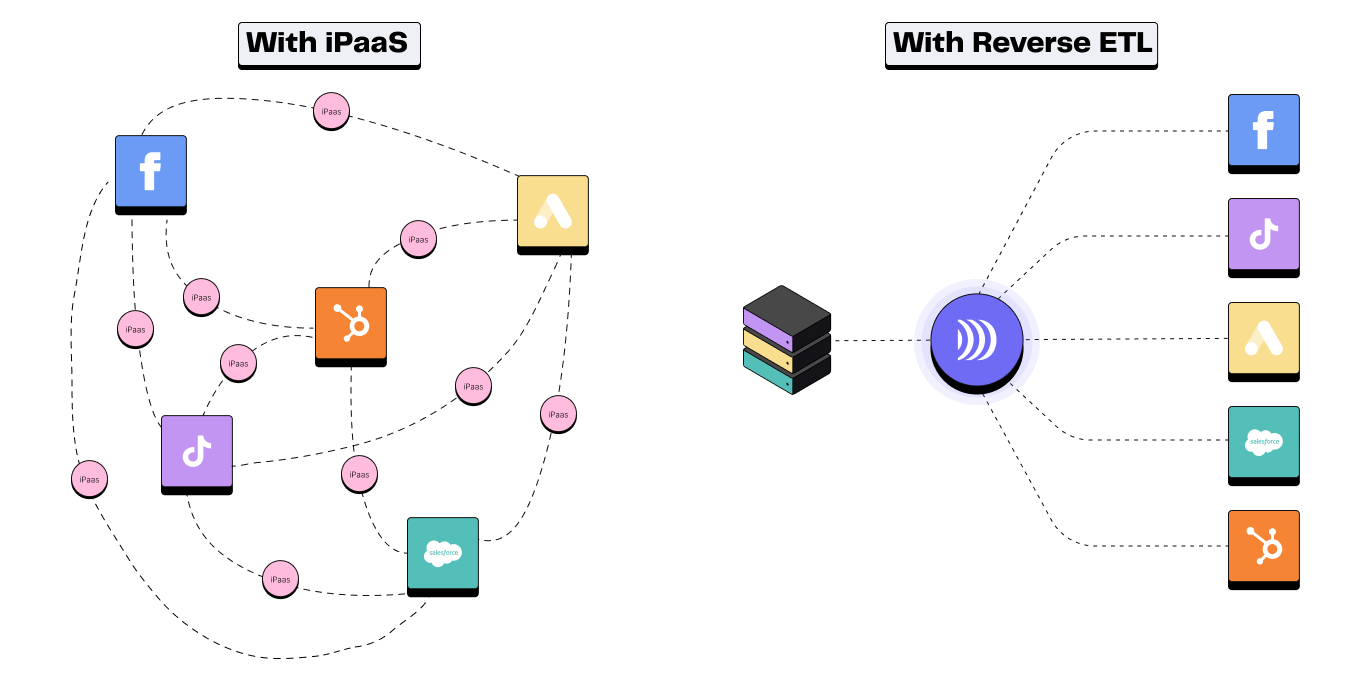
iPaaS vs. Reverse ETL
Reverse ETL vs. CDP
A Customer Data Platform (CDP) is an off-the-shelf platform that stores and organizes customer data from multiple sources to create a single source of truth. As such, CDP is an alternative to the data warehouse. Yet, the CDP offers advanced functionalities besides BI purposes:
Data preparation for business use cases: segmentation, creation of aggregates, customer scores, etc.
Activation to business applications
In short, CDP plays the same role as the combination of a data warehouse and reverse ETL.
Yet, in the 10 years or so that CDP have been around, the face of the data space has changed considerably and CDPs are no longer the most promoted solution. Only 1% of companies believe CDPs are actually meeting their current and future needs:
Rigidity: The CDP imposes its data models and limits the creation of customized models.
Price: A CDP is a costly solution, inaccessible to most small and medium-sized businesses.
Privacy: As it stores data, the CDP is a less secure solution
The reverse ETL process is part of the composable CDP, which sits on top of a cloud data warehouse and activates that data to many different destinations.
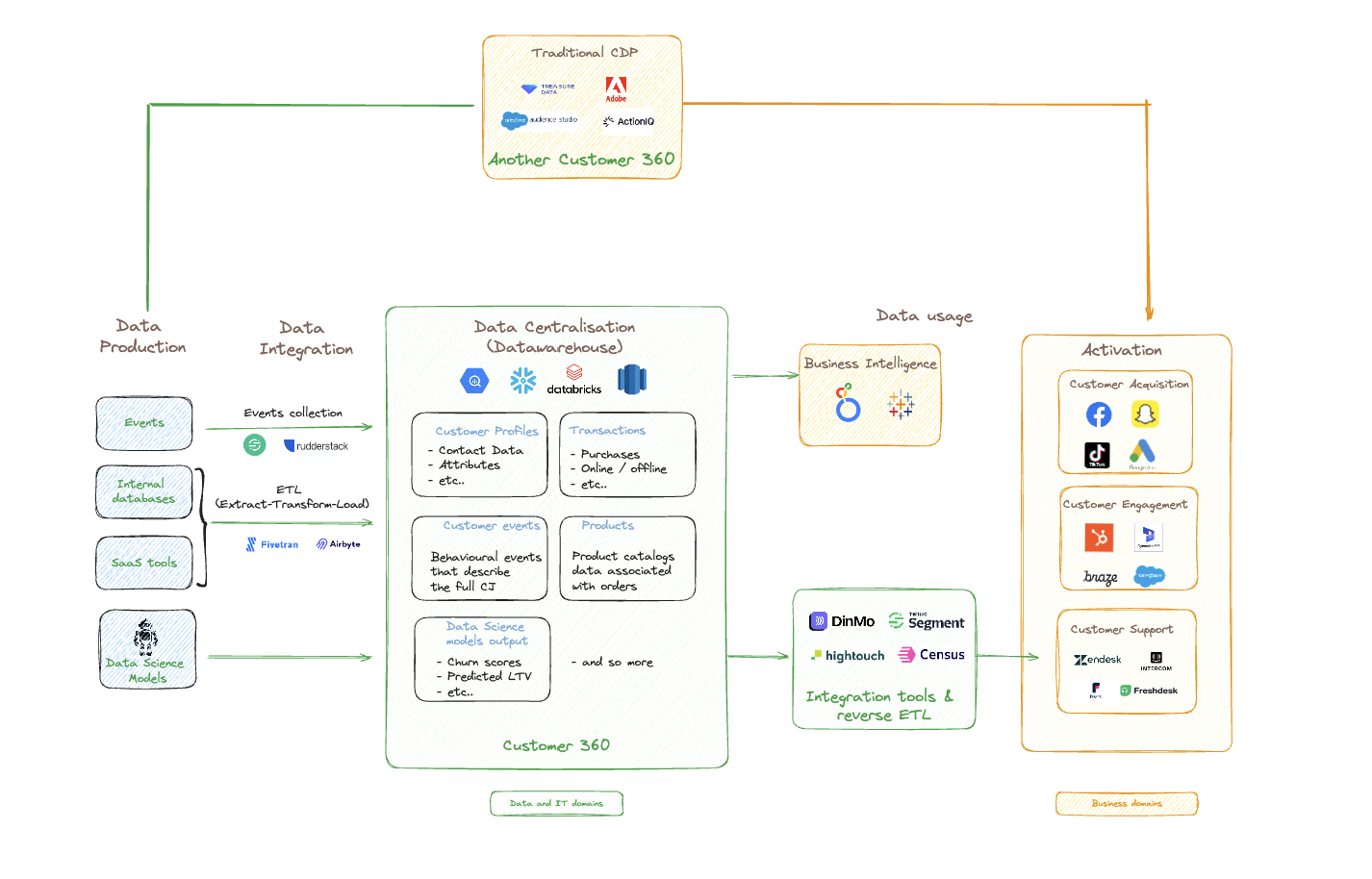
CDP vs. Reverse ETL
Benefits of reverse ETL
Reverse ETL helps companies ensure that their data is consistent and always up-to-date across their systems. Your data is then shared across operational systems and teams within your company, ensuring that your data doesn’t become siloed.
With that type of tool, you can achieve:
A 360° overview of your customer journey
The data team simply needs to make sure that the relevant data is accessible and ready for use in the data warehouse. Therefore, business teams can operate autonomously to perform analytics and get powerful insights in real time to improve the customer experience.
Quick, data-driven decision-making
Business teams can use Reverse ETL to gain access to fresh and always up-to-date. This data can be readily loaded into operational systems, ensuring that teams have timely insights. As a result, they can respond promptly to market shifts, customer demands, and emerging opportunities.
More personalized marketing content and campaigns
Advertising is one of the biggest use cases for Reverse ETL. Marketing teams often need to segment data for various purposes, such as creating lookalike audiences, excluding certain customer groups from campaigns, or retargeting top clients. With Reverse ETL, all audiences can be managed centrally and be synced in business platforms.
With Reverse ETL, you can send first-party data, such as attributes, traits or custom predictive metrics, to enrich your customer knowledge in your CRM / lifecycle marketing tools (such as Braze). This enables successful personalization of the customer journey.
Improvement of client operations
Sales tools can be enhanced with information that does not originally exist within them (product usage, channel preferences, etc.).
Support teams can also benefit from Reverse ETL because you can sync real time customer information in their system, so that they can prioritize support actions based on customer usage and contract value.
👉🏼 As many use cases are possible with Reverse ETL, we recommend consulting our dedicated resource.
Factors to Consider in a Reverse ETL tool
Before purchasing a Reverse ETL or attempting to build one yourself, it's important to know the key features to look for in a potential tool:
Support for your favorite tools: The efficacy and versatility of a reverse ETL tool are largely dependent on the range of destinations it can integrate and interact with. When selecting a tool, it's important to consider not only your immediate needs but also potential future requirements. A specific destination may only be available from a single provider (e.g. Batch).
Robust syncs: Data synchronization is arguably the most crucial aspect of a reverse ETL tool. It should be not only fast but also reliable. It's essential to choose a reverse ETL provider that uses an efficient approach to data synchronization, such as only syncing data that has been changed or updated. This approach results in substantial time and cost savings.
Powerful observability: A reverse ETL tool should provide robust monitoring capabilities that allow for quick error detection and resolution. Alerting features and clear, easy-to-understand monitoring features can significantly speed up the troubleshooting process, ensuring minimal disruption to your data teams.
Security: Data security is paramount when using a reverse ETL tool. Your chosen provider should have demonstrable compliance with all relevant regulatory requirements to ensure the protection of your sensitive data. For instance, this includes compliance with regulations like CCPA/GDPR, secure data storage practices, robust data encryption methods.
Ease of use: Reverse ETL tools are designed to streamline and simplify data management tasks, especially for business teams. Therefore, they should be user-friendly and accessible. Look for features like no-code functionalities, intuitive user interfaces, and straightforward data mapping processes that don't require advanced technical knowledge (of APIs for instance).
Ease of implementation: A good reverse ETL tool should be easy to set up and start using. The data model should be flexible enough to accommodate your specific needs, and anyone who has access to the data warehouse should be able to configure the tool without much difficulty.
Support: Data experts and resources (good documentation, tutorials, etc.) must be available to help your team overcome any obstacles.
Transparent and scalable Pricing: Of course, pricing is another important factor to consider when choosing a tool. Make sure you fully understand the provider's pricing structure, which might be based on the number of destinations or active syncs, for example. Also, consider how the cost might change based on your usage. While entry prices may initially seem reasonable, they can quickly escalate as your needs grow, so it's important to choose a solution that can scale with you.
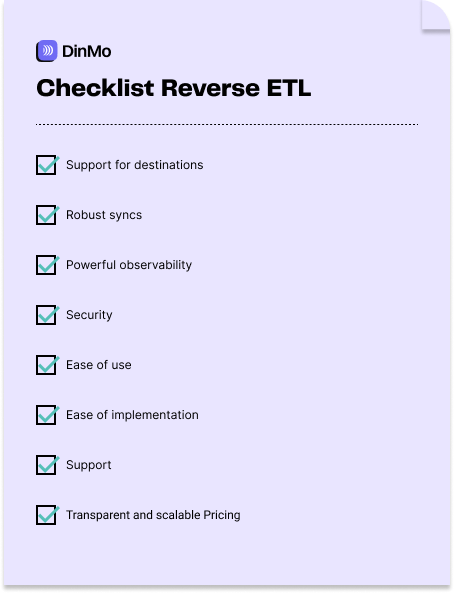
How to choose the correct platform?
Conclusion
As businesses strive to navigate the data landscape, Reverse ETL emerges as a key enabler for unlocking the true potential of centralized data. Its role in bridging the gap between data warehouses and business applications positions it as a transformative force in the modern data strategy toolkit. By understanding its functions and advantages, organizations can embark on a journey towards data-driven excellence.
👉🏼 If you want to invest in a first-class platform to enhance your data stack and an ETL solution up and running in minutes, schedule a demo with us.
💡If you'd like to find out more about how Reverse ETL can benefit your company or need help with data activation, please don't hesitate to contact me: alexandra@dinmo.com













